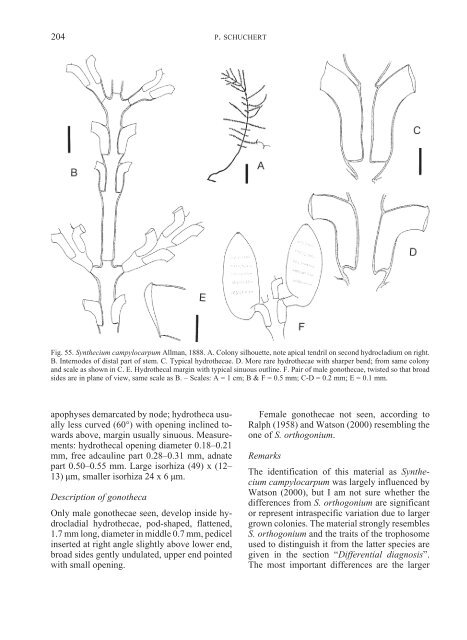Hydroids (Cnidaria, Hydrozoa) of the Danish expedition to
Hydroids (Cnidaria, Hydrozoa) of the Danish expedition to
Hydroids (Cnidaria, Hydrozoa) of the Danish expedition to
You also want an ePaper? Increase the reach of your titles
YUMPU automatically turns print PDFs into web optimized ePapers that Google loves.
204<br />
apophyses demarcated by node; hydro<strong>the</strong>ca usually<br />
less curved (60°) with opening inclined <strong>to</strong>wards<br />
above, margin usually sinuous. Measurements:<br />
hydro<strong>the</strong>cal opening diameter 0.18–0.21<br />
mm, free adcauline part 0.28–0.31 mm, adnate<br />
part 0.50–0.55 mm. Large isorhiza (49) x (12–<br />
13) µm, smaller isorhiza 24 x 6 µm.<br />
Description <strong>of</strong> gono<strong>the</strong>ca<br />
Only male gono<strong>the</strong>cae seen, develop inside hydrocladial<br />
hydro<strong>the</strong>cae, pod-shaped, flattened,<br />
1.7 mm long, diameter in middle 0.7 mm, pedicel<br />
inserted at right angle slightly above lower end,<br />
broad sides gently undulated, upper end pointed<br />
with small opening.<br />
P. SCHUCHERT<br />
Fig. 55. Syn<strong>the</strong>cium campylocarpum Allman, 1888. A. Colony silhouette, note apical tendril on second hydrocladium on right.<br />
B. Internodes <strong>of</strong> distal part <strong>of</strong> stem. C. Typical hydro<strong>the</strong>cae. D. More rare hydro<strong>the</strong>cae with sharper bend; from same colony<br />
and scale as shown in C. E. Hydro<strong>the</strong>cal margin with typical sinuous outline. F. Pair <strong>of</strong> male gono<strong>the</strong>cae, twisted so that broad<br />
sides are in plane <strong>of</strong> view, same scale as B. – Scales: A = 1 cm; B & F = 0.5 mm; C-D = 0.2 mm; E = 0.1 mm.<br />
Female gono<strong>the</strong>cae not seen, according <strong>to</strong><br />
Ralph (1958) and Watson (2000) resembling <strong>the</strong><br />
one <strong>of</strong> S. orthogonium.<br />
Remarks<br />
The identification <strong>of</strong> this material as Syn<strong>the</strong>cium<br />
campylocarpum was largely influenced by<br />
Watson (2000), but I am not sure whe<strong>the</strong>r <strong>the</strong><br />
differences from S. orthogonium are significant<br />
or represent intraspecific variation due <strong>to</strong> larger<br />
grown colonies. The material strongly resembles<br />
S. orthogonium and <strong>the</strong> traits <strong>of</strong> <strong>the</strong> trophosome<br />
used <strong>to</strong> distinguish it from <strong>the</strong> latter species are<br />
given in <strong>the</strong> section “Differential diagnosis”.<br />
The most important differences are <strong>the</strong> larger

















